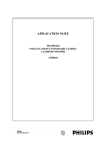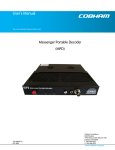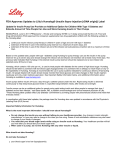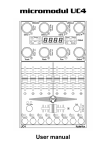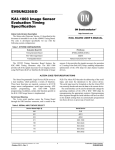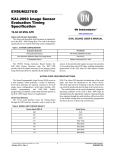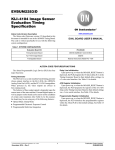Download TDA8787A Interface front end board camera CAMDEMO 8787A
Transcript
APPLICATION NOTE TDA8787A INTERFACE FRONT END BOARD CAMERA CAMDEMO 87A AN 00012 Philips Semiconductors TDA8787A Interface Front End Board for Camera Camdemo 87A Application Note AN 00012 Summary This application note describes on the one hand how to use the TDA8787A. On the other hand, an example of application is given using an Interface Front End (IFE) board performed with a TDA8787A , a ¼ “ medium resolution Sharp CCD sensor and its companion circuits. The front-end board has been developed in such a way that it can be easily connected to an evaluation board of the Philips DSP family. Associated with its sister DSP board built around the SAA8112, this IFE board gives an example of basic video camera application. All rights are reserved. Reproduction in whole or in part is prohibited without the prior consent of the copyright owner. The information presented in this document does not form part of any quotation or contract, is believed to be accurate and reliable and may be changed without notice. No liability will be accepted by the publisher for any consequence of its use. Publication thereof does not convey nor imply any license under patent - or other industrial or intellectual property rights. -2- Philips Semiconductors TDA8787A Interface Front End Board Camera Camdemo 87A APPLICATION NOTE TDA8787A INTERFACE FRONT END BOARD CAMERA CAMDEMO 8787A Author(s): Dominique LOYER S&A - Caen France PRELIMINARY Keywords: Imaging Camera Front end TDA8787A CCD Signal processor Date : February 2000 -3- Application Note AN 00012 Philips Semiconductors TDA8787A Interface Front End Board Camera Camdemo 87A Application Note AN 00012 CONTENTS 1 IC Front end TDA8787A description _______________________________________5 1.1 General Description ________________________________________________________ 5 1.2 Timing diagram____________________________________________________________ 7 1.3 Theory of operation ________________________________________________________ 9 1.3.1 1.3.2 1.3.3 1.3.4 1.3.5 1.3.6 Correlated Double Sampling (CDS) _______________________________________________9 Programmable Gain Amplifier __________________________________________________10 Input DC restoration or Input Bias Level Clamping__________________________________10 Black Level Clamping. ________________________________________________________11 Input Blanking. ______________________________________________________________11 OFDOUT function. ___________________________________________________________11 1.4 Serial interface____________________________________________________________ 12 1.5 Internal registers__________________________________________________________ 13 1.5.1 1.5.2 1.5.3 OFD function ________________________________________________________________13 PGA gain control_____________________________________________________________13 Control pulses polarity settings __________________________________________________14 2 Power and grounding recommendations ___________________________________15 3 Front end typical application_____________________________________________17 3.1 Interface connector pinning _________________________________________________ 19 3.2 Electrical diagrams ________________________________________________________ 21 3.3 Optical-mechanical block ___________________________________________________ 21 4 Enclosures ___________________________________________________________23 5 References ___________________________________________________________27 6 LIST of FIGURES_____________________________________________________28 -4- Philips Semiconductors TDA8787A Interface Front End Board Camera Camdemo 87A Application Note AN 00012 1 IC FRONT END TDA8787A DESCRIPTION 1.1 General Description The TDA8787A is a 3.3V, 10 bit analog-to-digital interface for CCD cameras. TDA8787A is a low power, low supply voltage circuit which is able to operate from 2.7 volts to 3.6 volts. Analog and digital supplies have several separated pins VCCA, VCCD and VCCO. Therefore special care must be taken when an application board is designed in order to avoid any external disturbing effect when using a non correct filtering circuit around these VCC’s lines. See Chapter 3. All digital inputs, as Standby inputs (STBY) and Output Enable Not (OE(N)) are TTL logic level compatible. In addition, the outputs are CMOS level compatible. No adaptation circuits has been required to interface output data with CMOS family circuit working under the same value voltage of power battery. Here is the list of the main functions implemented: . . . . . . . . Correlated Double Sampling circuit ( CDS ) Programmable Gain Amplifier(PGA) low power 10 bit Analog-to-Digital Converter integrated reference voltage regulator Serial Interface function for programming internal registers (SRI) 8 bit Digital-to-Analog Converter for extra external control function (OFD) Blanking interface Standby mode facilities The TDA8787A has a 18 MHz maximum clock frequency. -5- Philips Semiconductors Application Note AN 00012 TDA8787A Interface Front End Board Camera Camdemo 87A Here is the CCD signal path: CLPDM BLK Ref IN CDS SHIFT PGA shifter dac 7-bit CLAMP CLPOB Figure 1. CCD signal path -6- ADC Philips Semiconductors Application Note AN 00012 TDA8787A Interface Front End Board Camera Camdemo 87A 1.2 Timing diagram A typical input signal of CCD is depicted in Figure. 2, in comparison with SHP, SHD pulses, the Sample & Hold control pulses. The CCD signal can be divided into three main parts, the reset gate pulse, the reset hold level (floating gate or black level) and the actual video level. Figure 2. Typical CCD signal Reset Black level CCD signal Input IN N Video Th(SHP) SHP N Th(SHD) SHD N CLK Thold 11ns Data out N-3 N-2 -7- N-1 N Philips Semiconductors TDA8787A Interface Front End Board Camera Camdemo 87A Application Note AN 00012 Inside the TDA8787A, there is a pipeline delay between the external SHP and SHD signals present at the inputs and the actual internal switch action which samples the CCD signal. This delay is lower than 2 ns. This delay has to be taken into account during the definition of an application diagram to make sure the video signal is correctly processed and no overlap exists between the different sampled periods (black and active video) and SHP, SHD control pulses. -8- Philips Semiconductors TDA8787A Interface Front End Board Camera Camdemo 87A 1.3 Application Note AN 00012 Theory of operation 1.3.1 Correlated Double Sampling (CDS) Figure 3. shows the simplify block diagram of the TDA8787A’s CDS. The CDS is required in CCD systems as a mean for removing several types of noises. With video information, reset noise, thermal noise, 1/f noise generated are present at the CCD output signal. Since part of low frequencies noises are assumed to be correlated both during the active part of the video and during the feed through, major part of this noise can be cancelled by subtracting the feed through level from the video. This classical technique known as Doubled Correlated Sampling uses SHP and SHD pulses to control the internal process of CDS. The timings of the operation is describe in the Fig 3&4 in the TDA8787A’s Data Sheet. During SHP period, the sample & hold goes into the hold mode, taking a sample of the reset level (floating gate level) including the noise. At time SHD, the second sample & hold takes a sample of the video level. At the end, the result of this operation in the CDS is the generation of new signal which is now the true useful video level: Vreset – Vvideo. Then, this video level will be presented at the input of the digitally programmable gain amplifier tied down by DSP. The TDA8787A actually uses two CDS circuits in a “ping pong” way. This method reduces the bandwidth per stage as compared to a single channel CDS. Thus, the output from one of the two CDS is valid for an entire clock cycle. A and B are often named odd and even pixels. IN SHP.A A SHD.A A SHP.B B SHD.B B to PGA Figure 3. CDS block diagram -9- Philips Semiconductors Application Note AN 00012 TDA8787A Interface Front End Board Camera Camdemo 87A 1.3.2 Programmable Gain Amplifier The active video level varies according to the illumination of the scene observed. In order to ensure that the maximum of the useful dynamic range of the ADC is used even under low light conditions, the video signal is amplified, using this programmable gain amplifier loop (PGA). The gain range is 0dB—36dB. The amount of gain is adjusted by settings resulting of computation in the DSP and transmitted back to the TDA8787A amplifier by the 3 wires serial interface. 1.3.3 Input DC restoration or Input Bias Level Clamping The Figure 3 shows the input stage in a common application. The buffered video signal passes through the external coupling capacitor Cin. To restore the DC level to the desired baseline, a clamping circuit is used during the “dummy clamp” period (CLPDM = Low). In all applications, we advice to enable this loop all the time. CLPDM vcc Ref CCD CDS SHIFT PGA Cin CLAMP CLPOB Figure 4. Input Clamp - DC Restoration -10- Philips Semiconductors TDA8787A Interface Front End Board Camera Camdemo 87A Application Note AN 00012 1.3.4 Black Level Clamping. For a good signal processing, the video signal must be referenced to a well established “floating gate level” or “black level”. For this operation, the common way is to used the CCD’s optical black (OB) pixels, usually at the beginning of the CCD lines, as a calibration level. It is strongly recommended to reserve at least 12 black pixels. During this period, CLPOB active, the black level clamping measures the difference between the input level and the desired reference level. This reference level is programmed by the Serial Interface to set the desired “black color”. Of course, this black level offset is applied to both ways of the “ping pong” CDS. This reference level is hold in the capacitors CPCDS1&2. The calculation of these capacitors is fully dependent of the maximum ripple voltage acceptable and the pixel frequency. The next formula can be used to calculate them: CPCDS min = I Max _ load ∗ t load Vripple with I Max _ load = 350 µA at PGA code = 0 and I Max _ load = 10 µA at PGA code = 383; 1.3.5 Input Blanking. In many applications, the IFE is exposed to large input signals, mainly during the “blanking period” and in “ CCD shutter high speed” mode. To avoid problems with data processing, the TDA8787A includes a blanking function. When PBK is active, the digital outputs go to the desired clamp reference level. 1.3.6 OFDOUT function. To control the substrate bias level of some CCD’s, in order to cancelled the smear effect, the TDA8787A provides a voltage control output. This analog output is controlled via the Serial Interface by a 8-bit Digital-to-Analog Converter. The desired value is usually set during the calibration of the camera. -11- Philips Semiconductors TDA8787A Interface Front End Board Camera Camdemo 87A 1.4 Application Note AN 00012 Serial interface Communication with the configuration register is done through a Serial Interface (SRI). Just after the “power on” action, a message must be transmitted via the serial interface to the TDA8787A internal registers to set a correct working configuration. Maximum frequency: 5MHz. A writing sequence of a serial message is made of 10 data bit + 2 address bit. A1,A0, SD9,SD8,…,SD2,SD1; with A1 bit first sent. VSYNC signal can be used to synchronize the registers writing with the Vertical Drive (VD) signal in order to set all the parameters only after a complete image has been displayed. The polarity settings are excluded from the VSYNC latch. In some applications, this signal can be linked to SEN signal when the firmware takes account of VD. The setup and hold times, are described in the TDA8787A Data Sheet. Example: SDATA A1 A0 sd9 sd8 sd7 sd6 sd5 sd4 sd3 sd2 sd1 sd0 SCLK SEN VSYNC OR VSYNC -12- Philips Semiconductors Application Note AN 00012 TDA8787A Interface Front End Board Camera Camdemo 87A 1.5 Internal registers The configuration register is programmed to set the requested conditions : - PGA gain control; - OFD output control; - ADC clamp reference control (be careful SD7, SD8 and SD9 must be set to 0; - Controls pulse polarity settings for SHP, SHD ,CLAMP’s, PBK and CLK. Timing and polarity settings of all these signals, (active edge or level) are given in details in TDA8787A specification and can be summarized in the following tables. 1.5.1 OFD function Serial address A1A0= 01 Dec 0 255 hex 00 ff Typical Value of OFD out 0.0V 1.0 V 1.5.2 PGA gain control Serial address A1A0 = 00. SD9 = 0 Hex 000 040 080 0C0 100 13F 180 4.5dB +Gain 0 dB 6 dB 12 dB 18 dB 24 dB 30 dB 36 dB Bit 8 SD8 0 0 0 0 1 1 1 Bit 7 SD7 0 0 1 1 0 0 1 Bit 6 SD6 0 1 0 1 0 0 0 Bit 5 SD5 0 0 0 0 0 1 0 Bit 4 SD4 0 0 0 0 0 1 0 -13- Bit 3 SD3 0 0 0 0 0 1 0 Bit 2 SD2 0 0 0 0 0 1 0 Bit 1 SD1 0 0 0 0 0 1 0 Bit 0 SD0 0 0 0 0 0 1 0 dec 0 64 128 192 256 319 383 Philips Semiconductors TDA8787A Interface Front End Board Camera Camdemo 87A Application Note AN 00012 1.5.3 Control pulses polarity settings Serial address A1A0 = 11 SD0 =1 SD1=1 SD2=0 SD3=1 SD4 not used SD5=1 SD6=0 SHP, SHD active level HIGH CLK active edge RISING CLPDM always active level LOW CLPOB active level HIGH PBK active level HIGH VSYNC active edge RISING -14- Philips Semiconductors TDA8787A Interface Front End Board Camera Camdemo 87A 2 Application Note AN 00012 POWER AND GROUNDING RECOMMENDATIONS When designing a printed circuit board for application such as PC camera, surveillance cameras, camcorders and digital still cameras, care should be taken to minimize the noise. For the front end integrated circuit, the basic rules of printed circuit board design and implementation of analog components (such as classical operational amplifiers) must be respected, particularly for power and ground connections. Firstly, in all cases, we recommend to link the following pins on the same good ground: CPCDS1 CPCDS2 c c DCPLC c AGND Ground The following additional recommendation is given for the CDS input pins which are internally connected to the programmable gain amplifier. Secondly, the connections between the CCD, the CCD transistor interface and the CDS input should be as short as possible and a ground ring protection around these connections can be beneficial for noise performances. To separate analog and digital supplies provides the best solution. If it is not possible to do this on the board, then the analog supply pins must be de-coupled effectively from the digital supply pins. If the same power supply and ground are used for all pins the de-coupling capacitors must be placed as close as possible to the IC package. In a two-ground system, in order to minimize the noise through package and die parasitic, the following recommendations must be implemented: All the analog and digital supply pins must be well de-coupled to the analog ground plane. Only the ground pins associated to the digital outputs must be de-coupled to the digital ground plane. The analog and digital ground planes must be connected together at one point close to the ground pin associated with the digital outputs. The digital output pins and their associated lines should be shield by the digital ground plane which can be used then as return path for digital signal. -15- Philips Semiconductors Application Note AN 00012 TDA8787A Interface Front End Board Camera Camdemo 87A Never use a digital ground plane under analog wires and analog ground plane under digital connections. ID L VCC IA Power supply L VCC TDA8787A ia Analogue Digital C id C IA+ia Agnd Bounding resistor ID+id Dgnd Ground plane Figure 5. Grounding connections On the printed board area loop of supply current and impedance of different ground connections must be minimized, the de-coupling capacitors C (ceramic capacitor) must be placed as close as possible to the VCCA and VCCD pins. Series inductors in power supply lines may be used to improve de-coupling ( E.g. 1…5 µh or BLM components ). Using above de-coupling scheme, both analog and digital supplies can be connected together to a single stable 5 volt supply. -16- Philips Semiconductors TDA8787A Interface Front End Board Camera Camdemo 87A Application Note AN 00012 3 FRONT END TYPICAL APPLICATION The front end IC TDA8787A, used with one SAA 81XX of DSP Philips IC’s family, is the core of a high quality video application. Image sensor, vertical driver, timing generator, micro controller, memories, and DC-DC converter, are the others functions to build a modern CCD video camera A camdemo is made of two different boards: - An interface front end also called IFE board. A digital processing board. The whole camera is then made up with the following integrated circuits: - CCD sensor LZ 2413 for standard NTSC LZ2423 for PAL standard Vertical Driver (VD) LR36683 Pulse Pattern Generator (PPG) LZ95G55 Front End for analog processing and digitalization TDA8787A (FE) Digital Signal Processing and formatting ( DSP) SAA8112 Video encoder SAA7102 Memory EEPROM PCD8594 In addition on the IFE schematic, we find: - 2 simple small SMPS stages to transform the 5 volts power battery voltage into +15Volts and -8Volts needed to bias the CCD and Vertical Driver devices. One transistor buffer stage to interface the CCD with the FE; One non inverting amplifier stage to translate the OFDOUT signal of the FE to the FD input of the CCD; One push pull stage to transform the OFDX signal of the PPG into a high voltage pulse command added to the OFD on the FD CCD input (shutter function). These boards are connected together by a connector in order to be able to mix different configurations of our circuits ( TDA8784+SAA8112 or TDA8787A+SAA8112 …). In a previous application note, AN97037, evaluation board for camera more details can be found about the description of this concept. This present application has been modified in the front-end part only to become compatible with the TDA8787A circuit. -17- Philips Semiconductors TDA8787A Interface Front End Board Camera Camdemo 87A Application Note AN 00012 For people non-familiar with the DSP SAA81xx IC’s family, it is recommended to read this previous document to get better understanding of the DSP SAA8112 performance. If there is no basic change for the system point of view due to the substitution of the TDA8784 by TDA8787A, the use of new TDA 8787A circuit improves the global performance of the basic application: more simple connection with the PPG, lower noise, possible choice of the pulse polarity by software, lower power consumption and less external components. -18- Philips Semiconductors TDA8787A Interface Front End Board Camera Camdemo 87A 3.1 Application Note AN 00012 Interface connector pinning In the description list below and in the IFE diagram: - DS UC EE JB JD = = = = = DSP SAA8112 micro-controller implemented in the SAA8112 Eeprom I2C / UART connector digital output connector Names on connector 1 3 5 7 9 11 13 15 17 19 21 23 25 27 29 31 33 35 37 39 41 43 +5 V GND UC5 P1-3 UC2 P1 –0 CLK2 UC7 P1-5 PAL/NTSC UC29 P2-5 UC28 P2-4 UC27 P2-3 UC26 P2-2 P1 INPUT P0 INPUT DATA 8 DATA 6 DATA 5 DATA 3 DATA 1 SCLK INPUT SDATA INPUT STAND BY TDA GND +5V 2 4 6 8 10 12 14 16 18 20 22 24 26 28 30 32 34 36 38 40 42 44 -19- +5 V GND UC4 P1-2 CLK1 VD UC14 P3-2 HD UC16 P3-4 FI UC18 P3-6 GND +5 V n.u. UC25 P2-1 SMPS DATA 9 DATA 7 +5V n.u. GND DATA 4 DATA 2 DATA 0 SEN DACOUT GND 5 +V Philips Semiconductors TDA8787A Interface Front End Board Camera Camdemo 87A Names on micro-controller BIT P0.0 P0.1 NAME SCLE SDAE DESCRIPTION I2C bus clock for EEPROM I2C bus data for EEPROM P1.3 *P1.5 P1.6 P1.7 PPR_OEN TVMD SCLM SDAM TDA8787A Output Enable Not PPG mode select I2C bus clock for MMI I2C bus data for MMI P2.0 P2.1 P2.2 P2.3 P2.4 P2.6 PP_STDBY ACLXP EEUD EENR SMD1 POR TDA8787A standby pin PPG internal reset (all clear) PPG Electric Exposure 2 PPG Electric Exposure 3 PPG Shutter control 1 POR for DSP P3.0 P3.1 P3.2 *P3.6 P3.7 SNDA SNCL VD FI SNRST SNERT bus data for DSP SNERT bus clock for DSP VD interrupt input PPG Field Index SNERT bus reset for DSP -20- Application Note AN 00012 Philips Semiconductors TDA8787A Interface Front End Board Camera Camdemo 87A 3.2 Application Note AN 00012 Electrical diagrams Reported in enclosures. 3.3 Optical-mechanical block In the front of the TDA8787A there is a CCD sharp LZ2413 which is a ¼ type solid state image sensor having 542*498 pixels. This CCD is compatible with the NTSC standard. For a PAL application this CCD can be changed and directly replaced by the LZ2423 CCD type but in this case the quartz oscillator must be also changed: - 19.06993 MHz is used for NTSC standard; 19.3125 MHz is used for PAL standard; In the same time, the declaration of NTSC or PAL standards must be swapped in the setting of the DSP program and all parameters concerning the active and black windows pixels must be updated. It can be done with the Graphic User Interface (GUI) developed in our US laboratory, to demonstrated the SAA8112 possibilities (Reference N°2). In the front of the CCD, there is a optical low pass filter from American KSS, Inc. This particular filter is currently being produced by this manufacturer under the reference OG-BF389 (3122 168 7514.0), the size of this infrared filter is 7.75*7.25*3.27 mm and must be introduced in the optical block as shown below. Light from lens To CCD Figure 6. Optical filter -21- Philips Semiconductors TDA8787A Interface Front End Board Camera Camdemo 87A Application Note AN 00012 In addition each kit is containing the following elements: - 1 piece CS mount interface 1 piece under-plate 1 piece CS mount ring 1 piece retaining ring 1 piece filter foan 2 screws M2.5. The IFE kit can be delivered with CS CCTV lens coming from different suppliers. Lens which generally are 4mm F 1.2 or 8 mm F1.2 depending available material in stock. Documentation on these elements are available on request. -22- Philips Semiconductors TDA8787A Interface Front End Board Camera Camdemo 87A 4 ENCLOSURES -23- Application Note AN 00012 Philips Semiconductors TDA8787A Interface Front End Board Camera Camdemo 87A -24- Application Note AN 00012 Philips Semiconductors TDA8787A Interface Front End Board Camera Camdemo 87A Application Note AN 00012 Figure 7. Electrical schematic Figure 8. Components implementation upper side -25- Philips Semiconductors TDA8787A Interface Front End Board Camera Camdemo 87A Application Note AN 00012 Figure 9. components implementation lower side -26- Philips Semiconductors TDA8787A Interface Front End Board Camera Camdemo 87A 5 REFERENCES 1) Application Note AN97037 – May 1992 Camera evaluation board documentation SDA8112-TDA8786 Author: Stephane Desproges 2) Addendum to AN97037 – June 1997 Camera I’C controller software documentation and user manual Author: Jürgen Krehnke 3) Caen Team Design – Internal Note Authors: S. Jacquet, R. Morisson 4) Software for TDA8787A, version V3.12 (Modification of V3.11 for TDA8786 by C. Kohler and H. Jacquemin) . -27- Application Note AN 00012 Philips Semiconductors TDA8787A Interface Front End Board Camera Camdemo 87A Application Note AN 00012 6 LIST OF FIGURES Figure 1. CCD signal path __________________________________________________________________6 Figure 2. Typical CCD signal________________________________________________________________7 Figure 3. CDS block diagram ________________________________________________________________9 Figure 4. Input Clamp - DC Restoration ______________________________________________________10 Figure 5. Grounding connections ____________________________________________________________16 Figure 6. Optical filter ____________________________________________________________________21 Figure 7. Electrical schematic ______________________________________________________________25 Figure 8. Components implementation upper side _______________________________________________25 Figure 9. components implementation lower side _______________________________________________26 -28-




























